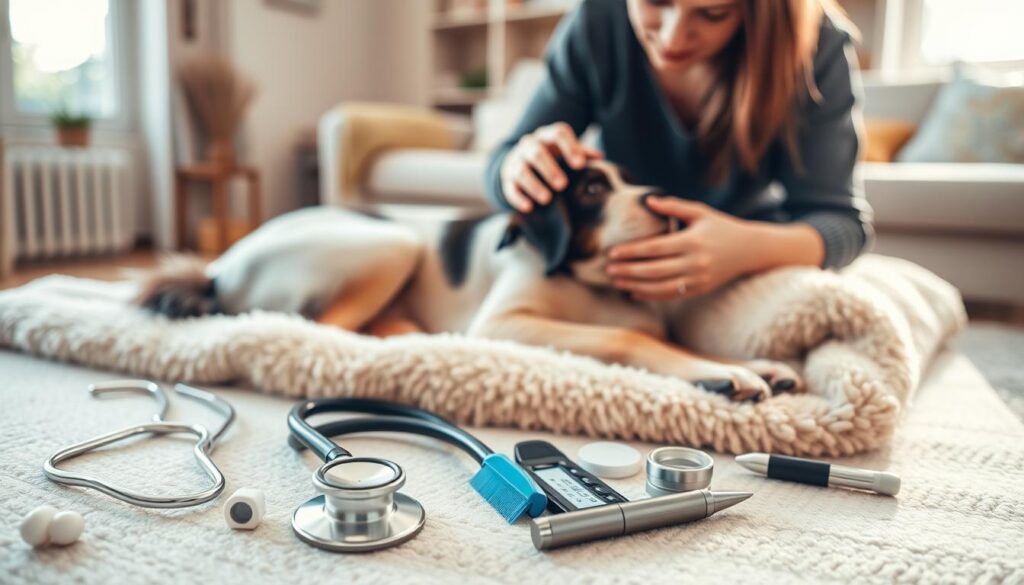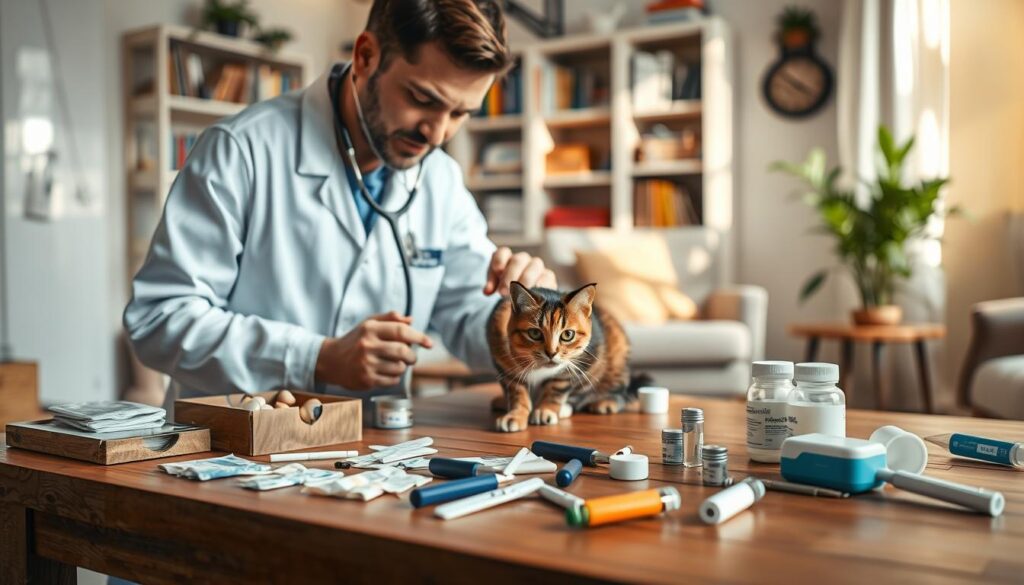At-Home Pet Check-Up: Monitor Their Health Easily

As a responsible dog owner, you want to ensure your furry friend stays happy and healthy throughout their life. Understanding what's normal for your pet is crucial in identifying any changes or potential issues early on.
Giving your dog a regular health check at home can help you notice problems before they become severe, making treatment more effective and affordable. By doing so, you'll not only strengthen the bond between you and your dog but also gain peace of mind about their wellbeing.
This comprehensive guide will walk you through the simple way to perform effective at-home health assessments, enabling you to provide better care for your pet.
Why Regular Health Monitoring Matters for Your Pet
Monitoring your pet's health regularly is essential for early detection of potential issues. By doing so, you can identify any deviations from their normal condition and take prompt action.
Regular health checks allow you to establish a baseline for your pet's normal state, making it easier to notice subtle changes that could indicate a health problem. This baseline includes understanding your pet's normal behavior, appearance, and bodily functions.
Establishing a Baseline for Your Pet's Normal Condition
Understanding what's normal for your pet is vital. This includes knowing their vital signs, energy levels, and physical characteristics. By becoming familiar with these aspects, you'll be better equipped to detect any changes that might signify a health issue.
| Aspect | Normal Condition | Potential Issue |
|---|---|---|
| Energy Levels | Active and playful | Lethargic or less active |
| Appetite | Eats regularly | Loss of appetite |
| Bodily Functions | Normal urination and defecation | Changes in frequency or consistency |
Early Detection Leads to Better Treatment Outcomes
Early detection of health issues through regular monitoring can lead to less invasive treatments, better prognosis, and lower veterinary costs. Health issues caught early are typically easier to treat and have better outcomes than those discovered at advanced stages.
Regular monitoring can help detect chronic conditions that develop gradually and might otherwise go unnoticed until they become serious. By being proactive, you can ensure your pet receives the care they need in a timely manner.
Preparing for an Effective Home Pet Health Check
To ensure a successful home pet health check, preparation is key. Your dog's health is in your hands, and being prepared makes all the difference.
Creating a Comfortable Environment for Your Pet
Not all pets are comfortable with being checked or touched in certain areas. Always make sure your pet is relaxed and comfortable during a health check. Create a calm, quiet environment to help your pet feel safe and relaxed. Timing is also crucial; perform health checks when your pet is naturally calm and content.
Tools and Supplies That Make Checks Easier
Having the right tools on hand can make health checks easier. Essential supplies include a pet thermometer, a small flashlight, and grooming tools. Gradually acclimating your pet to being handled and examined in various areas through positive reinforcement is also important. You can make the health check a positive experience by using treats and praise during and after the check.
- A calm environment helps in reducing stress for your pet.
- Use treats and praise to make the experience positive.
- Essential tools include a thermometer and grooming tools.

Observing Behavior: Your First Clue to Health Issues
Observing your dog's behavior is crucial for identifying potential health issues early on. One of the most crucial aspects of a home wellness check involves simply observing your dog. You should pay attention to their usual energy levels, enthusiasm for walks and playtime, and overall mood.
Changes in Activity, Playfulness, and Mood
Is your typically bouncy dog suddenly lethargic? Have they lost interest in their favorite toys? Are they exhibiting any signs of anxiety, restlessness, or irritability? Changes in behavior can be subtle indicators of underlying health concerns. Keep an eye on your dog's activity levels and playfulness, as changes can be early signs of health problems.
Monitoring Eating, Drinking, and Bathroom Habits
Pay close attention to your dog's eating and drinking habits. Have they experienced a loss of appetite or increased thirst? Note the frequency and consistency of their bowel movements and urination. Monitoring these habits can help you identify potential health issues, such as gastrointestinal problems or urinary tract infections. Any significant changes should be documented and discussed with your veterinarian.
Complete Home Pet Health Check: A Step-by-Step Guide
Checking your pet's health at home is a simple yet effective way to ensure their health and detect any potential issues early. By following a systematic approach, you can monitor your pet's overall condition and identify any signs of illness or discomfort.
Examining the Eyes: What Healthy Eyes Look Like
When checking your dog's eyes, look for brightness and alertness. A small amount of brown discharge around the corners is normal due to tear production, and you can simply wipe it clean with a tissue. However, be on the lookout for signs of redness, discharge, or cloudiness, as these could indicate an issue.
Checking the Ears for Infection and Irritation
Your dog's ears can be a good indicator of their health. Give them a sniff to check for any unusual odors, which could be a sign of infection. Visually inspect the ears for excess dirt, discharge, or swelling. If you notice any of these signs, it may be worth consulting a vet.
Inspecting the Mouth, Teeth, and Gums
To check your dog's mouth, gently lift their lips. Look for normal pink gums; pale or bluish gums are a cause for concern. Check the teeth for brown tartar buildup and any signs of redness along the gum line. This simple check can help identify dental issues early on.
Nose and Breathing Assessment
Assess your dog's nose and breathing when they are resting or asleep. Count their breaths per minute to ensure their respiratory rate is normal. Any unusual labored breathing or rapid breathing should be investigated further.
Feeling for Lumps, Bumps, and Abnormalities
Run your hands over your dog's body to feel for any lumps, bumps, or tender areas. Check for areas of hair loss, rashes, crusting, or redness. This hands-on check can help you identify any abnormalities that may need veterinary attention.
| Body Part | What to Look For | Potential Issue |
|---|---|---|
| Eyes | Redness, discharge, cloudiness | Infection, injury |
| Ears | Unusual odor, discharge, swelling | Infection, irritation |
| Mouth/Teeth/Gums | Tartar buildup, redness, pale gums | Dental issues, gum disease |
| Nose/Breathing | Labored or rapid breathing | Respiratory issues |
| Body | Lumps, bumps, hair loss, rashes | Skin issues, tumors |
Coat and Skin Health: What to Look For
Checking your dog's coat and skin regularly can help you identify potential health issues early on. A healthy coat is shiny, smooth, and free of mats, while a dull, brittle, or excessively shedding coat can be a sign of underlying health problems.
Healthy vs. Problematic Skin Conditions
A dog's skin should be free of redness, rashes, and irritation. Signs of healthy skin include a consistent color and texture. On the other hand, problematic skin conditions can manifest as dryness, oiliness, flakiness, or unusual pigmentation. Regularly inspecting your dog's skin can help you catch these issues early.
Checking for Parasites and Irritations
When examining your dog's skin, look for signs of parasites like fleas, ticks, and mites. Also, check for any areas of irritation, such as redness, rashes, or crusting. Observing your dog's behavior can also provide clues; if they're excessively biting, scratching, or chewing at their skin, it may indicate an underlying issue.
Tracking Your Pet's Health Between Vet Visits
By regularly checking your dog's health at home, you can identify potential issues early on. This proactive approach to your pet's health involves maintaining a record of their condition and any changes you observe.
Creating a Simple Health Journal
A health journal for your pet can be a valuable tool. Record your dog's weight, appetite, and any changes in behavior or physical condition. Note any medications or supplements they're taking. This information will be helpful during vet visits. Explore various pet health monitoring tools that can complement your journal.
Using Technology to Monitor Pet Health
Technology offers various ways to track your pet's health. Consider using apps or digital devices designed for pet health monitoring. These tools can help you keep a consistent record of your dog's health checks and provide insights into their condition. Make sure to choose tools that are user-friendly and reliable.

Conclusion: Partnering with Your Vet for Optimal Pet Health
Regular health checks at home, paired with professional vet care, empower you to be a more effective advocate for your pet's health. This partnership ensures your dog receives comprehensive care.
By working together with your vet, you're giving your pet the best chance at a happy, healthy life. Make sure to check your dog regularly and maintain a close eye on their overall health.

Leave a Reply